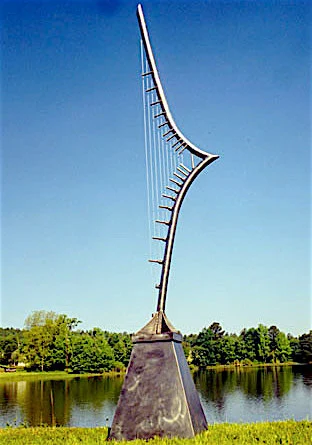Introduction
Synthesising the Aeolian harp is part of a project into synthesising sounds that fall into a class called aeroacoustics. The synthesis model operates in real-time and is based on the physics that generate the sounds in nature.
The Aeolian harp is an instrument that is played by the wind. It is believed to date back to ancient Greece; legend states that King David hung a harp in the tree to hear it being played by the wind. They became popular in Europe in the romantic period and Aeolian harps can be designed as garden ornaments, part of sculptures or large scale sound installations.
Basic Principles
As air flows past a cylinder vortices are shed at a frequency that is proportional to the cylinder diameter and speed of the air. This has been discussed in the previous blog entry on Aeolian tones. We now think of the cylinders as a string, like that of a harp, guitar, violin, etc. When a string of one of these instruments is plucked it vibrates at it’s natural frequency. The natural frequency is proportional to the tension, length and mass of the string.
Instead of a pluck or a bow exciting a string, in an Aeolian harp it is the vortex shedding that stimulates the strings. When the frequency of the vortex shedding is in the region of the natural vibration frequency of the string, or one of it’s harmonics, a phenomenon known as lock-in occurs. While in lock-in the string starts to vibrate at the relevant harmonic frequency. For a range of airspeed the string vibration is the dominant factor that dictates the frequency of the vortex shedding; changing the air speed does not change the frequency of vortex shedding, hence the process is locked-in.
Our Model
As with the Aeolian tone model we calculate the frequency of vortex shedding for a given string dimensions and airspeed. We also calculate the fundamental natural vibrational frequency and harmonics of a string given its properties.
There is a specific area of airspeed that leads to string vibration and vortex shedding locking in. This is calculated and the specific frequencies for the FM acoustic signal generated. There is a hysteresis effect on the vibration amplitude based on the increase and decrease of the airspeed which is also implemented.
A used interface is provided that allows a user to select up to 13 strings, adjusting their length, diameter, tension, mass and the amount of damping (which reduces the vibration effects as the harmonic number increases). This interface is shown below which includes presets of an number of different string and wind configurations.

